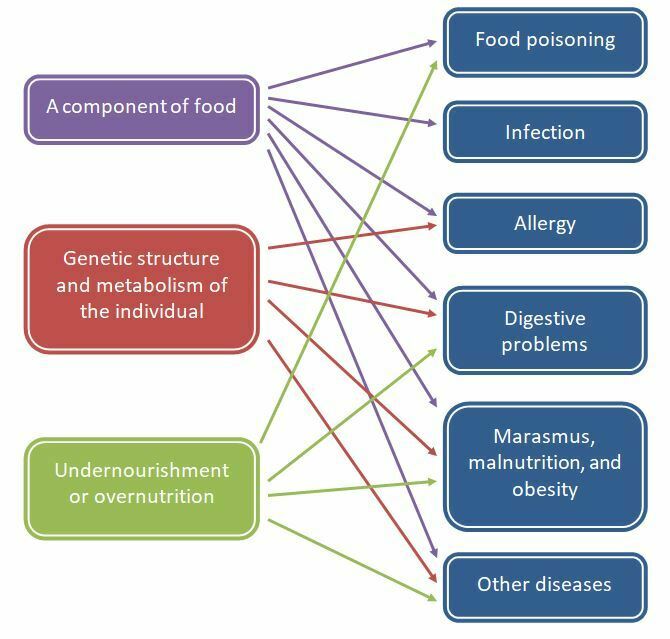Foodborne Diseases in History
Foods, as well as being a source of health and healing, can negatively affect health in some cases; can cause significant illness, disease and death. Foodborne diseases and the relationship between food and health -as far as can be understood- have been known for about 7 thousand years. It is known that some plants were consumed and traded for healing in the 5000s BC.
Foodborne illnesses and deaths have always occurred throughout history. Although we do not have enough data, we can come to some conclusions about the food-related problems that human beings have experienced throughout history, based on the existing data.
Considering that the first humans ate the food they could find; they may have experienced health problems from eating raw meat, poisonous mushrooms and indigestible plants contaminated with microorganisms.
Since they are the easiest prey and the weakest and sickest animals in hunting, the ingestion of diseased animal meat may also have created serious problems. The discovery of fire is very important for this period in terms of reducing the microorganism load in foods and making food safer.
The birth of agriculture in the Neolithic period provided food abundance, but agriculture probably introduced human beings to new diseases. Because of animal husbandry, human beings have started to interact with animals and nature and many pathogens that have not been met before have been transmitted from animals to humans.
Storage of excess food produced in agriculture has also created problems such as mold formation, deterioration and contamination of food. The consumption of these foods will inevitably create important health problems. It can be said that the transition to collective life in this period also paved the way for mass food poisoning.
Along with agriculture, ergotism has become a disease that threatens humanity. Ergotism occurs as a result of ergots produced by a fungus, Claviceps purpurea, contaminated with grains and consuming these grains.
Grains that are mainly affected are wheat, barley, rye, and oats. Consumption of ergot grains can cause severe hallucinations or gangrene with a high fever.
Ergotism can be found in the Assyrians, in the ancient Egyptian civilization, as well as in the Middle Ages and even in the 20th century.
In the memoirs of the Greek general Xenophon, he mentions an expedition to the Persian Empire in 401 BC. The expedition does not go as expected and the army of 10 thousand soldiers engages in a withdrawal maneuver.
While retreating, the army, which plundered and plundered everywhere, reached the Black Sea shores and began plundering the honey hives there. However, this honey is not ordinary honey and the whole army gets drunk from it; Vomiting and nausea begin to appear in the soldiers. After all, it takes a few days for the army to recover.
The presence of poisonous honey on the shores of the Black Sea was interestingly used as a war strategy. In 67 BC, the Roman Empire organized an expedition to destroy the Pontus Empire located on the shores of the Black Sea.
Pontus King IV. Mithridates is clever; He allows the Roman army to enter the Pontus territory. The Roman general Pompey, who is unaware of the strategy, establishes a headquarters in the region and his soldiers begin to plunder the honey hives in the region.
The army is poisoned by honey; intoxication and vomiting begin in the soldiers. This is exactly what the King of Pontus has already aimed; Drunk and suffering from vomiting, he destroyed three troops in the Roman army by taking advantage of this negligence. The Roman military is forced to retreat.
Foodborne lead poisoning has particular importance in human history. So much so that although some sages warned humanity against lead in their own time, food poisoning was experienced due to lead for about 5000 years.
Since lead is an easily available and easily processed mineral, from 3500 BC onwards, mankind has widely used lead to produce vessels and pipes. The preparation and consumption of especially acidic foods in lead containers have caused people to be poisoned by lead.
Similarly, using lead pipes in drinking water transmission lines was an important health problem in Roman civilization; but this was unknown.
The situation, which was direr for Roman civilization, was experienced when it was realized that the wines produced in lead containers were more delicious. The lead of the vessel combines with the acetic acid released during the production of the wine to form lead acetate and this compound is quite sweet.
Thus, the production of wine in lead containers became popular and liters of wine was drunk daily, even a teaspoon of which was poisonous. Lead poisoning is a type of poisoning that causes problems such as paralysis, epilepsy and painful stomach pains in the body over a long period rather than an instant effect.
Hippocrates (460 – 377 BC) was the first to notice the negative effects of lead; Nicander (197 – 130 BC) demonstrated lead poisoning. In the 1st century BC, Dioscorides and Plinius the Elder also warned the public that wine produced in lead vessels was a source of a nervous breakdown. But society did not take into account the sages.
Some researchers think that the wines produced in lead containers for the sake of taste brought about the end of Roman civilization.
Lead poisoning from wine continued into the Middle and New Ages. After examining the body of Pope Clement, who died in 1047, it was determined that his death was caused by chronic lead poisoning.
The negative health effects of leaded wines were described by Gockel in 1694. The legalization of lead-containing wines took place in 1696.
In the period from the Neolithic period to the 19th century, human beings have become accustomed to collective life and there is a development from colony to the city and state structuring.
However, the accumulation and increase of the population in certain regions have brought the problem of dense human excrement accumulation in that region. This problem naturally increased the risk of contamination of feces with food.
The absence of an effective fecal removal and sewage system has also paved the way for many fecal-borne food diseases. This problem remained serious until the 1850s in London, which is now considered the center of civilization.
As of the 19th century, the development of science and technology is very important in terms of ensuring food safety. Effective sewage systems and machines such as refrigerators and ovens ensured healthy food consumption.
The fact that science began to explain the causes of diseases allowed human beings to better understand the relationship between food and health. In this way, necessary measures were taken in terms of food safety.
In history, the first identified and documented food-related death was the death of Alexander the Great. Researchers believe that Alexander the Great concluded that he died of typhoid fever caused by Salmonella typhi found in the food he ate in 323 BC.
A clear understanding of the cause of diseases and deaths occurred with the development of science and technology in the 19th century and later.
However, since the official number of problems caused by food is as much as the number of recorded cases, it is estimated that the total number of cases with unrecorded cases is higher.
Overview of foodborne diseases
According to data from the World Health Organization, there are more than 200 diseases caused by food today and it is calculated that approximately 420 thousand people die annually due to various foodborne diseases.
Children under the age of 5 accounts for 40% of food-related deaths. 125,000 children die each year from foodborne illnesses.
Diarrheal diseases are one of the most common foodborne diseases. 550 million people suffer from diarrhea each year due to unhealthy food consumption. As a result of diarrhea cases, 230 thousand of people die every year.
The reasons for the negative effects of food on health can be evaluated under three different headings. These reasons;
1. A component of food
2. Genetic structure and metabolism of the individual
3. Undernourishment or overnutrition.
Food can become unhealthy for these four main reasons. Due to these reasons, different health problems may occur due to food and nutrition. Foodborne diseases can be categorized as follows;
1. Food poisoning
2. Infection
3. Allergy
4. Digestive problems
5. Marasmus, malnutrition and obesity
6. Other diseases (cancer, diabetes, cardiovascular diseases, kidney and liver failure, neurological disorders, tooth decay, etc.)
This is the general framework of the causes and types of foodborne diseases. However, the cause-and-effect relationship is quite complex and intricate. For example, food poisoning can be caused by microorganisms or it can be caused by a component in the food. Similarly, different components found in food can have a toxic effect as well as cause many different health problems.

Since the issue of foodborne diseases is a very comprehensive and intricate subject, it is very difficult to categorize it and deal with it as a whole. In numerous sources published in Turkish and other languages, this subject is discussed in different forms and scopes. In order to better understand the whole subject, the subject of food-borne diseases has been discussed from two different perspectives, the causes and the health problems that occur, in a way that covers the whole. The subject of food-borne diseases has been written as a series of 3 articles. The first article provides an overview of foodborne illness and a history of foodborne illness. The second article covers the causes of diseases (see Foodborne Diseases – II: Causes). In the third article, the types of foodborne diseases and the precautions that can be taken against these diseases are discussed (see Foodborne Diseases – III: Diseases and Measures to be Taken).



Be First to Comment